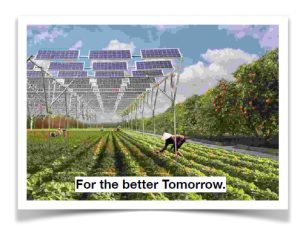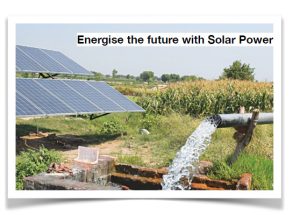Sanjana P. Vernekar, Vellore Institute of Technology
The article outlines numerous key components of solar powered irrigation, with different specifications – the present scenario of India, the different methodologies that have been employed and the future potential of Solar Powered Irrigation.
As a dependable, clean-energy alternative for agricultural water management, solar power has grown more and more essential for farmers, especially in regions with high sun radiation levels. A resource that is freely available and made possible by solar irrigation technology allows local farmers to plan better and improve their stock levels for marketing in a reliable, highly efficient manner. A cleaner, more sustainable system that reduces the expenditure of farming greatly. Farming business has benefited greatly from solar irrigation. When practised on a wide scale, farming is a costly endeavour that uses a lot of power. Therefore, if you use solar powered irrigation in farming some of the expenses will be decreased. The solar panel receives sunlight, which converts the solar power to electrical power causing it to produce electrical energy. This electrical energy powers a motor and a flywheel, which in turn power the piston, which takes in and pushes out water. As a result of this system’s simplicity, the farmer will experience reduced downtime and expenditure due to fewer moving components and less maintenance.
To grow the greatest quality crops in the most efficient manner, plants must receive the appropriate amount of water at the appropriate time. Crop wilting, soil erosion, and inadequate plant nutrient absorption will result from either too little or too much water. Irrigation is the regulated use of water to meet the demands of crops.
Better agricultural practices are encouraged by a good irrigation system, which furthers the goal of eradicating all hunger. The use of solar power to produce energy and deliver power is on the rise. Hence, solar energy has become more and more essential in agriculture as a dependable, clean-energy alternative for agricultural water management, especially in locations with high incident solar radiation. The primary benefit of using solar energy or the sun for irrigation is that crops require a lot of water when it is sunny, and solar energy directly harnesses energy from the sun to create a lot of energy when it is required. When groundwater is the only supply of water or when surface water needs to be transported over great distances, Solar Powered Irrigation System (SPIS) can help mitigate the effects of drought and alleviate water stress during the dry season. Water carrying can be replaced with solar PV pumps, which can also free up a significant amount of time that can be used for useful endeavours like dry season farming.
For consumers in rural areas without stable access to electrical networks or where fuel is expensive and challenging to get, solar power can be a way to provide access to energy for agriculture. Improvements in income, food and nutrition security, as well as enhanced availability to water during dry spells and dry seasons, are possible additional benefits. Understanding solar-powered irrigation systems is essential because they provide a method for managing water in agriculture. In order to ensure sustainable use of water resources and prevent excessive groundwater abstraction, SPIS should be incorporated into robust regulatory frameworks on water conservation. SPIS can also reduce GreenHouse Gas emissions from irrigated agriculture and enable low-emission irrigation development.
The actual components and hardware needs vary according to the type of irrigation system, for example:
Surface irrigation, in which water is moved across the surface of agricultural lands.
Localised irrigation, like spray or drip or trickle system where water is applied to each plant or adjacent to it.
Sprinkler irrigation, in which water is piped to one or more central locations within the field and distributed by overhead high-pressure sprinklers or guns.
One of the main parts of a conventional solar powered pumping system is a solar panel array that powers a surface pump or a borewell pump. The size of the entire system depends on the size of the pump, how much water is needed each day, and how much solar power is available. Water is frequently pumped from a bore-well or stream into a storage tank or directly into the field. The solar-powered irrigation system is composed of three basic components: Pump motor, Pump controller, solar cell
Specifications and requirements of solar water pumps
Motor pump – Delivering water to the field! Everyone who has ever hauled water for any distance from a river or well is aware of the effort required. It is not surprising, then, that people have sought ways to lessen the workload and increase the efficiency of lifting water over the years. Pumps that require either manual labour or fuel (petrol, diesel, or electricity) have advanced in recent years as the primary means of transporting water for irrigation. These water pumps are made to transport more water to the field with a minimum of work on the part of the farmer. They have mainly been successful in this, but they continue to be rather demanding. They need a lot of upkeep, a steady supply of fuel (either human energy or fossil fuel), and someone to keep an eye on them while they are operating. The voltage of the solar pump motor can be either AC or DC, depending on the type of motor used. Instead of 12-volts, most DC pumps operate at 24-volts. For lighter-duty applications, 12-volt systems are smaller, and 48-volt systems are available for heavier-duty ones. A motor’s power is measured in watts or horsepower (HP).
Types of Motor Pumps
Solar Photovoltaic water pumping systems can employ any of the motor pump sets depending on their construction and applications listed below.
- Surface mounted motor pump-set
- Submersible motor pump set
- Floating motor pump set
- Any other type of motor pump set after approval from the Ministry test centres.
Surface Pump – Since a surface pump is often situated above the water, a suction lift is needed. When a strong flow and a low head (the height to which the water needs to be lifted) are necessary, it is used to release water from an open well, pond, or river.
Submersible Pump – Essentially, this pump is a completely enclosed motor. The entire submersible pump unit is submerged in the water being pumped. It is made to fit inside the drilled bore and is typically used to pump water from small bore-wells. The depth of the well could range from a few metres to 500 metres. Yet, the system would be more powerful and costlier the deeper the hole. The ability to push water higher is a feature of submersible pumps.
How to Select the Right Pump? Knowing the depth at which water is present, the amount of water needed each day, and the kind of irrigation system that will be installed are all important considerations when purchasing a pump. The water flow rate and the total pump head must also be known. The most efficient pumps are those that have the best head and flow rate ratios while using the least amount of energy.
Pump controller – SPS are essential for optimising pump efficiency. The water pump can basically be controlled by controllers. The life of your pump can be extended by using controllers to turn on and off the pump, establish a schedule for its operation, and set a pumping schedule. Water-sensing controllers assist in shutting off the pump when there is insufficient water if you are pumping from a well or water source that frequently experiences low water levels or dry conditions. Inverter and variable frequency drive are the two different kinds of pump controllers (VFD). When using an AC solar pump, an inverter is required to convert the DC generated by the solar cells into AC. The inrush feature of an AC motor must be accommodated by appropriately sizing the solar panel and inverter. The inverter ought to be able to manage this additional start-up load because the AC pump needs a lot of power at first. To make sure that the pump motor receives the correct voltage and amperage, a VFD controller may occasionally be used. For many solar DC pumps to be powered exclusively by PV panels, a special controller is needed (without batteries). The pump can start and operate in dim lighting during cloudy days, early mornings, and late evenings thanks to the controller or linear current booster (maximum power point tracker). For a DC pump with a battery power supply, the controller might not even be necessary.
Solar panel – Bringing solar energy into the blend! The amount of solar energy that reaches the Earth in a single hour is greater than what the complete world uses in a year! The photovoltaic effect is used to generate energy by the solar panels used in the solar water pump systems. These solar panels transform solar photons into energy by absorbing them. The primary part of a solar water pump system is this. Array refers to a collection of solar panels. The pumps are outfitted with motors that are powered by solar PV arrays. A solar module’s nominal power is measured in peak wattage (Wp). The wattage of solar panels is determined by the demand and the motors used. The government of India recommends solar PV arrays with capacities ranging from 200W to 5kWp. Use of PV modules with higher power output is preferred.
Tracking System and Mounting Structures. In order to support the load of the modules and high wind speeds of up to 160 km/h, the PV modules should be installed on steel structures with sufficient strength and proper design. The pumping system’s support structure should be made of hot-dip galvanised iron with a minimum thickness of 85 microns. Manual, passive, or automatic tracking techniques must be employed to improve the performance of SPV water pumping systems. For manual tracking, arrangements for daily manual tracking three times and seasonal tilt angle adjustment should be made.
Switch On/Off
The motor pump set must come with a solid, durable switch that can be used with both DC and AC power. The PV array and the motor pump set should be connected with a sufficient length of cable.
Protections and Sensors
To use the solar panel as efficiently as possible and to maximise the water discharge, Maximum Power Point Tracker (MPPT) should be included.
If necessary, an inverter might be used to run an ac pump. A motor pump set should have adequate precautions against dry operation, lightning, hail, and storms. It should be possible to give complete protection against open circuit, unintentional short circuit, and reverse polarity.
Verify the following before purchasing the system:
Site for installing a solar water pump. Before installing it, you should confirm whether a pond, river, well, or another location is nearby. Pump depth adjustment. The different accessories needed for underground installation would raise the overall cost.
Water use on a daily basis. Equipment that is heavier and more powerful is required if you need more water every day.
Pumps can be AC or DC. A solar panel, pump controller (inverter), module mounting assembly, and extras like cables, connections, and pipe are required for an AC pump. In the case of a direct connection with the PV panel, a pump controller for the DC pump would not be necessary. In addition, solar trackers and pump protection units can be installed.
In order to be assured that the water gets to all the parts of the farmland; which depends on the area of the farm and capacity of the pump, it can be done by partitioning the site. The farm can be partitioned in such a way the water be directed to a particular section of the farmland. Once the water has been channelled to the required area then the water can be directed to another part, until all parts are well watered. With this method, the water is able to get around the farmland in an easy and convenient way. A comprehensive toolbox on Solar Powered Irrigation System should be developed, for technical advisors in order to train users and assess impacts. A regular field visit should be conducted in the initial stage to gauge the situation of the water system at the farmland, the in-site visits will increase the knowledge and understanding of the structure and implementation for future advancements in the system.
India’s Solar Irrigation System’s Present Situation
Around 60% of Indians are employed in agriculture as farmers. However, even if the land is fertile, irrigation becomes challenging owing to the lack of energy in remote places because it relies solely on rainfall. Solar energy can prevent suicides among Indian farmers who are normally at risk of it (during periods of drought and little rainfall).
Even in remote locations, irrigation is possible with solar water pumping devices. The pumps can be used for many different irrigation applications, such as paddy fields, horticultural farms, gardens, etc. Another issue at the moment is that both farmers and customers are not aware of the advantages.
Solar Irrigation System – Future Scope
Technology developments might make the systems more user-friendly. With your mobile phone, you may operate the motor pump remotely. With your cell phone, you may view the reservoir and overhead storage tank’s water level. These technologies are already available on the market; however, they are not widely used.



